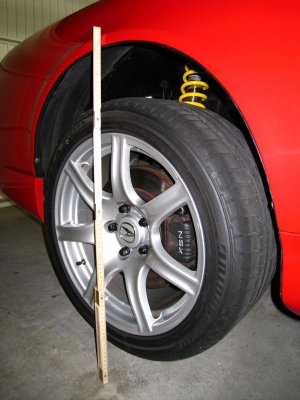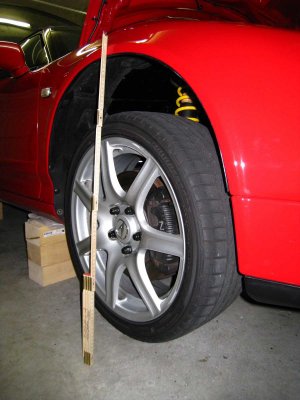Well, soon there will be another Ohlins suspension offering for our NSX application.
I've been working with Bruce of Performance Shock Inc. (located at Sonoma Raceway) on a mostly-street application for the Ohlins TTX.
So far, they've done one other NSX application - Kip Olson's rebuilt race NSX where they recently ditched the Penske's and went with these Ohlins TTX coilovers. Apparently Kip likes these a lot better according to Driving Ambition media posts.
Anyways, that's a track application where mine is more of an aggressive street driver with maybe a few track days per year. Mine is a 2700lb wet car with most creature comforts removed. Power varies from ~300 WHP (N/A) to ~525 WHP (F/I) depending on what I'm experimenting on. I've had this car for almost 15 years and my priority now is the most comfortable ride I can get while still being sporty. It also needs to accommodate my four-wheel lift kit which is a must for any kind of daily driving.
I've waited years for an electronically-available adaptive suspension that I could retrofit. The one that still holds the most promise in my opinion is the Tenneco Driv or other variant. However, I think a generic release is still years away, and it is questionable if it could be adapted to my lift cups.
[MENTION=20915]RYU[/MENTION] suggested I look into the Ohlins DFV offering a few years ago which has had a lot of success in the Porsche, BMW, and S2000 (with the longer stroke dampers) worlds for some time. I liked what I read, and had a chance to compare two BMWs back-to-back with DFVs and KW V3's on the street. I really liked the DFVs. At the time, no one had an off-the-shelf kit available for the NSX, so Ohlins corporate in NC referred me to Performance Shock Inc. From exhaustive internet searches, PSi is the premier Ohlins folks for DFV and TTX applications. I never found one negative review on them. Their work is highly regarded... Check out this Porsche CGT Ohlins TTX application they did years ago:
https://rennlist.com/forums/porsche-supercars-carrera-gt-918-960/731597-psi-ohlins-ttx-porsche-cgt-suspension-system.html
The craftsmanship and attention to detail is amazing, and I knew they could easily handle my request.
Unfortunately, they're located in CA and I'm in PA. Other than the DA NSX, which isn't quite representative of my ride height and top mount attachment, they have not measured another NSX for fitment. So, I pulled off a front and rear old coilover and sent it to them for measurement. I also provided them with a few other measurements such as the suspension motion ratios at my desired ride height (the geometry varies), the car weight and distribution, and unsprung weight. They dyno'd my old coilovers and measured the spring rates. Everything has been optimized to maximize suspension travel which isn't easy... especially with the shock stroke taken up with my lift cups.
PSi has been very patient answering my many questions, mocking up dampers to send me for test fitment, taking measurements and pictures, and fabricating special mounts to maximize travel. Check out this steel inverted clevis they're working on to accommodate the top spherical bearing. THIS is the way you orient spherical bearings to place them in the correct loading position and maximize their life. Unfortunately, very few do this correctly:
View attachment 155250
The picture above is the front application where this inverted clevis design is needed. It also shows the TTX ILX (a bit more expensive but it doesn't require a piggyback or remote canister which makes it much easier to deal with on a street car). The blue tape on the shaft represents the thickness of the lift piston. The blue tape on the damper body represents where it will be shortened up to gain stroke (spring perch threads will go almost to the end). To save money and because we have sufficient stroke in the rear already, we're using one of their other normal clevis mounts and adapting it to my old coilover aluminum top mounts. This was the mockup for the rear with the cup in place:
View attachment 155248
You can see how easy it is to rotate the knobs and adjust dampening for the track!
When I asked PSi about going with DFVs or the TTXs for my intended usage, I was convinced to go with these TTXs. You won't find many sample shock dynos for these, but based on their unique design they are extremely flexible in the tuning range. I'm hoping to find a good soft street setting and then adjust for tracks later.
Unfortunately, this has taken longer than both Bruce and I thought. The combination of race season, physical separation, and adaption for my lift pistons has resulted in a bit longer wait than we'd hoped, but the end is very near. The good news for others is that it should be worked out when you go to order :wink:
I've been working with Bruce of Performance Shock Inc. (located at Sonoma Raceway) on a mostly-street application for the Ohlins TTX.
So far, they've done one other NSX application - Kip Olson's rebuilt race NSX where they recently ditched the Penske's and went with these Ohlins TTX coilovers. Apparently Kip likes these a lot better according to Driving Ambition media posts.
Anyways, that's a track application where mine is more of an aggressive street driver with maybe a few track days per year. Mine is a 2700lb wet car with most creature comforts removed. Power varies from ~300 WHP (N/A) to ~525 WHP (F/I) depending on what I'm experimenting on. I've had this car for almost 15 years and my priority now is the most comfortable ride I can get while still being sporty. It also needs to accommodate my four-wheel lift kit which is a must for any kind of daily driving.
I've waited years for an electronically-available adaptive suspension that I could retrofit. The one that still holds the most promise in my opinion is the Tenneco Driv or other variant. However, I think a generic release is still years away, and it is questionable if it could be adapted to my lift cups.
[MENTION=20915]RYU[/MENTION] suggested I look into the Ohlins DFV offering a few years ago which has had a lot of success in the Porsche, BMW, and S2000 (with the longer stroke dampers) worlds for some time. I liked what I read, and had a chance to compare two BMWs back-to-back with DFVs and KW V3's on the street. I really liked the DFVs. At the time, no one had an off-the-shelf kit available for the NSX, so Ohlins corporate in NC referred me to Performance Shock Inc. From exhaustive internet searches, PSi is the premier Ohlins folks for DFV and TTX applications. I never found one negative review on them. Their work is highly regarded... Check out this Porsche CGT Ohlins TTX application they did years ago:
https://rennlist.com/forums/porsche-supercars-carrera-gt-918-960/731597-psi-ohlins-ttx-porsche-cgt-suspension-system.html
The craftsmanship and attention to detail is amazing, and I knew they could easily handle my request.
Unfortunately, they're located in CA and I'm in PA. Other than the DA NSX, which isn't quite representative of my ride height and top mount attachment, they have not measured another NSX for fitment. So, I pulled off a front and rear old coilover and sent it to them for measurement. I also provided them with a few other measurements such as the suspension motion ratios at my desired ride height (the geometry varies), the car weight and distribution, and unsprung weight. They dyno'd my old coilovers and measured the spring rates. Everything has been optimized to maximize suspension travel which isn't easy... especially with the shock stroke taken up with my lift cups.
PSi has been very patient answering my many questions, mocking up dampers to send me for test fitment, taking measurements and pictures, and fabricating special mounts to maximize travel. Check out this steel inverted clevis they're working on to accommodate the top spherical bearing. THIS is the way you orient spherical bearings to place them in the correct loading position and maximize their life. Unfortunately, very few do this correctly:
View attachment 155250
The picture above is the front application where this inverted clevis design is needed. It also shows the TTX ILX (a bit more expensive but it doesn't require a piggyback or remote canister which makes it much easier to deal with on a street car). The blue tape on the shaft represents the thickness of the lift piston. The blue tape on the damper body represents where it will be shortened up to gain stroke (spring perch threads will go almost to the end). To save money and because we have sufficient stroke in the rear already, we're using one of their other normal clevis mounts and adapting it to my old coilover aluminum top mounts. This was the mockup for the rear with the cup in place:
View attachment 155248
You can see how easy it is to rotate the knobs and adjust dampening for the track!
When I asked PSi about going with DFVs or the TTXs for my intended usage, I was convinced to go with these TTXs. You won't find many sample shock dynos for these, but based on their unique design they are extremely flexible in the tuning range. I'm hoping to find a good soft street setting and then adjust for tracks later.
Unfortunately, this has taken longer than both Bruce and I thought. The combination of race season, physical separation, and adaption for my lift pistons has resulted in a bit longer wait than we'd hoped, but the end is very near. The good news for others is that it should be worked out when you go to order :wink:
Last edited:










